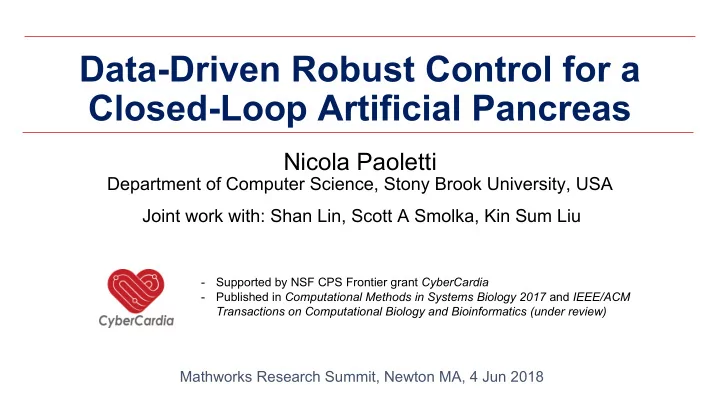

Data-Driven Robust Control for a Closed-Loop Artificial Pancreas Nicola Paoletti Department of Computer Science, Stony Brook University, USA Joint work with: Shan Lin, Scott A Smolka, Kin Sum Liu - Supported by NSF CPS Frontier grant CyberCardia - Published in Computational Methods in Systems Biology 2017 and IEEE/ACM Transactions on Computational Biology and Bioinformatics (under review) Mathworks Research Summit, Newton MA, 4 Jun 2018
Type 1 diabetes (T1D) WHO Global report on diabetes, 2016
T1D therapy Glucose monitor (CGM) Insulin pump Detects sugars levels Delivers bolus insulin (to cover meals) and under the skin basal insulin (to cover demand outside meals) LIMITATIONS - Pump and CGM don’t communicate with each other - Bolus is manually set by the patient with meal announcements → danger of wrong dosing Image from: https://www.medtronic-diabetes.com.au/pump-therapy/what-is- insulin-pump-therapy
Closed-loop control, aka Artificial Pancreas (AP) Insulin Glucose-insulin metabolism Challenges CGM PUMP → CGM is a “derived” measure of BG (noisy and delayed) Sugar levels → Disturbances related to patient behavior (Meals and Exercise) Not just medical but also a CPS challenge
Artificial Pancreas, a control problem OUR SOLUTION : Data-driven robust model predictive control (MPC) for the AP: - Closed-loop control of both basal and bolus insulin - Handles uncertainty by learning from data - Accurate state estimation from CGM measurements
Data-driven uncertainty sets - Learn from data uncertainty sets that capture realizations of random disturbances (meal and exercise) - Method that provides uncertainty sets with probabilistic guarantees [Bertsimas et al., Mathematical Programming 167(2), 235–292, 2018] : Uncertainty Sets Meal/exercise data (questionnaires, surveys, sensors, …) (mmol/min) Carbs Time (min)
Insulin control and state estimation, formally Robust MPC: - Find the insulin therapy that minimizes the worst case performance w.r.t. unknown disturbances - Performance: distance of predicted glucose from target + step-wise discrepancy of control strategy Moving Horizon Estimator (MHE), “Estimation a la MPC”: - Uses a model to minimize distance between predicted and actual measurements, and between predicted and estimated states over a moving window of length N - It works also as a meal estimator: estimates the most-likely uncertainty parameter values
Virtual patient learnt from NHANES database GROUP 1: Carbs-rich breakfast - We learn patient models from CDC’s NHANES Carbs (mmol/min) - Meal data from 8,611 participants - Data clustered into 10 main groups Time (min) T hypo T in range T hyper Perfect 0% 100% 0% Non-robust 18.5% 80.97% 0.53% Robust 2.02% 93.45% 4.52%
Summary - Data-driven robust MPC approach for insulin therapy - In-silico evaluation on real and synthetic data - Towards fully closed-loop diabetes therapy Ongoing and future work - Formal synthesis of robust PID controllers [HVC’17] [ICCAD’18, submitted] - “Human-in-the-loop” control - Evaluation on real devices and patients
Recommend
More recommend